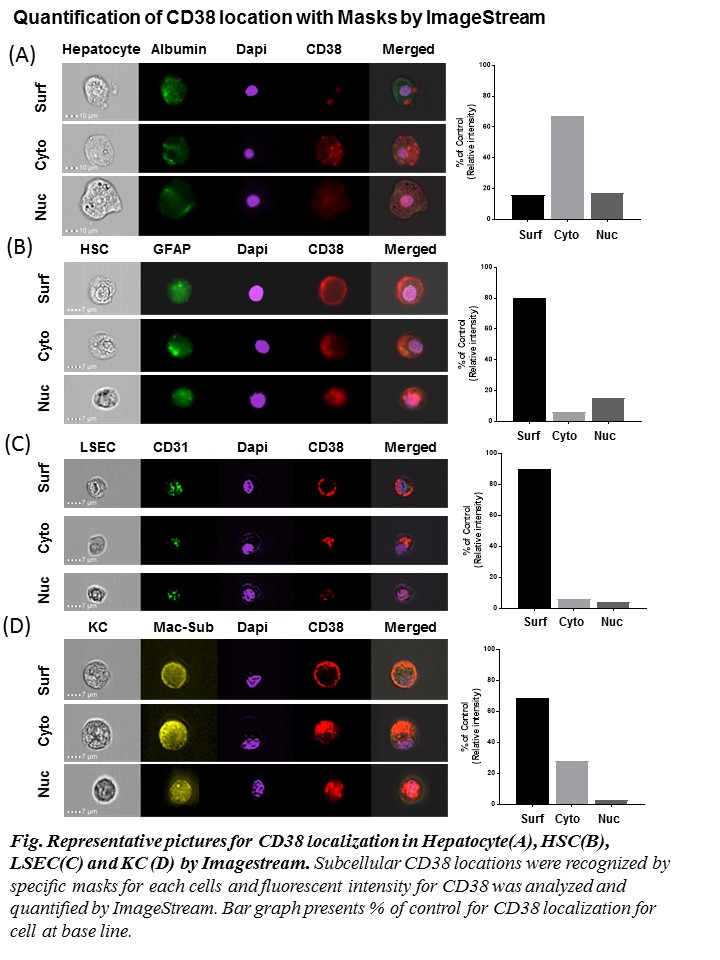Utilizing Imagestream Technology to Determine Hepatocellular CD38 Localization
Department of Cardiac Surgery, The Ohio State Univ. Medical Center, Columbus, OH
Meeting: 2019 American Transplant Congress
Abstract number: A178
Keywords: Bioengineering, Liver
Session Information
Session Name: Poster Session A: Biomarkers, Immune Monitoring and Outcomes
Session Type: Poster Session
Date: Saturday, June 1, 2019
Session Time: 5:30pm-7:30pm
 Presentation Time: 5:30pm-7:30pm
Presentation Time: 5:30pm-7:30pm
Location: Hall C & D
*Purpose: CD38 is an ecto-enzyme that modulates intracellular calcium levels by producing potent secondary messengers, which utilize the cellular NAD pool and lead to increased oxidative stress and inflammation. Increased CD38 expression has been associated with marginal organs, ischemia/reperfusion injury, and as a biomarker for fibrosis and transplant rejection. However, data suggest that surface expression of CD38 may not be fully predictive of function after injury or rejection, because CD38 activity and function can depend on the cell compartment distribution (plasma membrane, cytosol, nuclear membrane). Standard techniques of quantifying location have limitations. While flow cytometry is efficient, quantifying the surface and intracellular expression of the same protein can be hard to resolve. Confocal microscopy has increased resolution, but low throughput and quantification is difficult. In this study, we demonstrate how ImageStream® addresses this unmet need for a technique to determine CD38 localization.
*Methods: ImageStream® technology is a novel technology that combines flow cytometry and microscopy. We utilize novel antibody staining techniques and masking strategies to quantify CD38 subcellular expression with high resolution and throughput in primary rat liver cells at baseline. We use this new strategies to evaluate CD38 changes in a fatty liver injury model.
*Results: We found that all of the four major liver cell types express CD38 to varying degrees at baseline. Hepatocytes show the lowest levels of CD38 expression with a predominance of intracellular expression, while LSECs, KCs, and HSCs show high surface expression of CD38. Moreover, we quantified CD38 cellular distribution ratio. The surface : cytoplasm : nucleus ratio for CD38 localization for cells at baseline are as follows: 16% : 67% : 17% for hepatocytes, 80% : 6% : 14% for HSCs, 90% : 6% : 4% for LSECs, and 69% : 28% :3% for KCs.
*Conclusions: We have optimized an ImageStream technique that will allow us to efficiently and effectively determine shifts in CD38 location and to more accurately quantify expression of the biomarker CD38. This strategy may allow us to capture more information we can use for prediction of function during rejection or in marginal livers. Future studies will use this strategy to predict marginal organ function post-transplantation with human liver biopsies. This technique can be expanded to other molecules or biomarkers with multiple subcellular locations or transitions.
To cite this abstract in AMA style:
Lee Y, Kim J, Reader BF, Akateh C, Maynard KR, Washburn KW, Zweier JL, Whitson BA, Black SM. Utilizing Imagestream Technology to Determine Hepatocellular CD38 Localization [abstract]. Am J Transplant. 2019; 19 (suppl 3). https://atcmeetingabstracts.com/abstract/utilizing-imagestream-technology-to-determine-hepatocellular-cd38-localization/. Accessed December 20, 2025.« Back to 2019 American Transplant Congress

